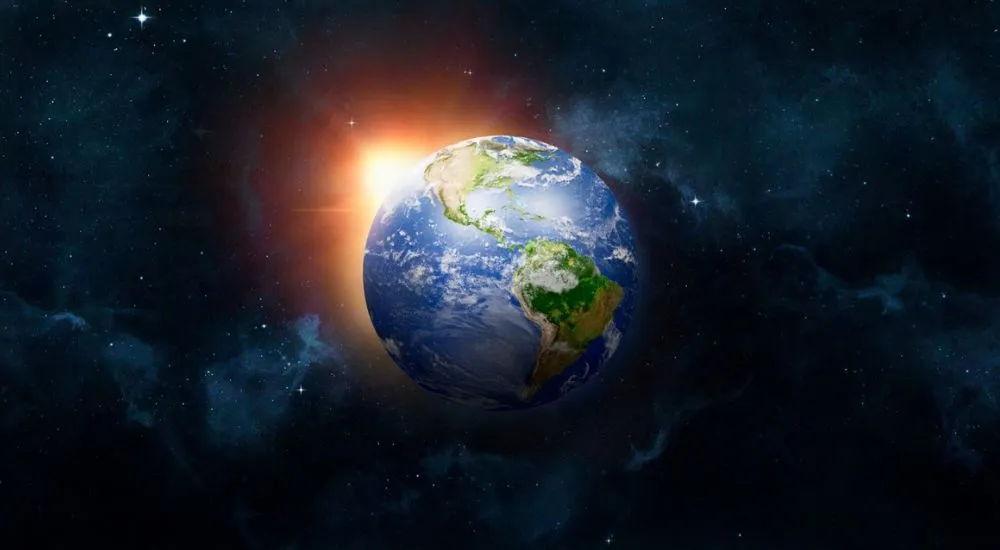21. What is the primary source of energy driving Earth’s internal processes?
(A) Sun
(B) Geothermal heat
(C) Nuclear fusion
(D) Earth’s rotation
(B) Geothermal heat
Explanation: Geothermal heat, generated by the slow decay of radioactive isotopes in the Earth’s interior, is the primary source of energy driving Earth’s internal processes such as plate tectonics and volcanic activity.
22. What is the main source of energy driving the water cycle on Earth?
(A) Earth’s internal heat
(B) The Sun
(C) Ocean currents
(D) Wind patterns
(B) The Sun
Explanation: The Sun provides the energy necessary for the water cycle, driving processes such as evaporation, condensation, and precipitation.
23. What was the primary source of Earth’s early atmosphere?
(A) Volcanic outgassing
(B) Biological activity
(C) Meteorite impacts
(D) Extraterrestrial gases
(A) Volcanic outgassing
Explanation: The Earth’s early atmosphere primarily evolved through outgassing, where gases trapped within the planet’s interior were released during volcanic activity.
24. What is the primary source of evidence for Earth’s geological history?
(A) Fossils
(B) Seismic waves
(C) Ice cores
(D) Tree rings
(A) Fossils
Explanation: Fossils provide valuable evidence for Earth’s geological history, helping scientists understand past environments, the evolution of life, and the changing Earth over time.
25. What evidence supports the hypothesis of early life on Earth?
(A) Fossil records
(B) Paleo magnetism
(C) Radioactive dating
(D) Seismic waves
(A) Fossil records
Explanation: Fossil records provide evidence of early life on Earth. Microbial fossils, stromatolites, and chemical signatures found in ancient rocks suggest the presence of early life forms.
26. Which oceanic phenomenon of Earth is caused by the gravitational pull of the Moon and the Sun?
(A) Tides
(B) Tsunamis
(C) Currents
(D) Waves
(A) Tides
Explanation: Tides are caused by the gravitational pull of the Moon and the Sun on Earth’s oceans, leading to the rise and fall of sea levels at regular intervals.
27. What phenomenon causes day and night on Earth?
(A) Earth’s revolution around the Sun
(B) Earth’s axial tilt
(C) Earth’s rotation on its axis
(D) Earth’s elliptical orbit
(C) Earth’s rotation on its axis
Explanation: Day and night are caused by Earth’s rotation on its axis. As Earth rotates, different parts of the planet are exposed to sunlight, resulting in day, while the parts facing away from the Sun experience night.
28. What is the primary cause of Earth’s seasons?
(A) The distance of Earth from the Sun
(B) The tilt of Earth’s axis
(C) The shape of Earth’s orbit
(D) The rotation of Earth on its axis
(B) The tilt of Earth’s axis
Explanation: Earth’s seasons are primarily caused by the tilt of its axis, which is about 23.5 degrees. This tilt causes different parts of Earth to receive varying amounts of sunlight throughout the year.
29. What is the average distance between Earth and the Sun?
(A) 15 million km
(B) 93 million km
(C) 150 million km
(D) 300 million km
(C) 150 million km
Explanation: The average distance between Earth and the Sun is approximately 150 million km (about 93 million miles). This distance is also known as 1 Astronomical Unit (AU), which is a standard measure used to describe distances within our solar system.
30. What is the average distance between Earth and its natural satellite, the Moon?
(A) 38,000 km
(B) 380,000 km
(C) 3,800,000 km
(D) 38,000,000 km
(B) 380,000 km
Explanation: The average distance between Earth and the Moon is approximately 380,000 km (about 238,855 miles). This distance varies slightly due to the elliptical shape of the Moon’s orbit around Earth.
31. At what altitude does a geostationary satellite typically orbit the Earth?
(A) 200 km
(B) 1,000 km
(C) 35,786 km
(D) 60,000 km
(C) 35,786 km
Explanation: A geostationary satellite orbits the Earth at an altitude of approximately 35,786 km (22,236 miles) above the equator. This specific altitude allows the satellite to synchronize its orbit with the Earth’s rotation, maintaining a fixed position relative to the surface.
32. Which refers the situation when the sun is directly overhead at the equator making the length of day and night equal?
(A) Equinox
(B) Solstice
(C) Eclipse
(D) Winter
(A) Equinox
Explanation: Twice a year, around March 21st and September 23rd, the Sun appears directly above the Earth’s equator, resulting in nearly equal lengths of day and night across the globe. This situation is known as equinox.
33. On which date does the vernal equinox typically occur?
(A) March 21
(B) June 21
(C) September 23
(D) December 21
(A) March 21
Explanation: The vernal equinox typically occurs around March 21. This equinox marks the beginning of spring in the Northern Hemisphere and autumn in the Southern Hemisphere, with nearly equal lengths of day and night.
34. On which date does the summer solstice typically occur in the Northern Hemisphere?
(A) March 21
(B) June 21
(C) September 23
(D) December 21
(B) June 21
Explanation: The summer solstice in the Northern Hemisphere typically occurs around June 21. This date marks the longest day of the year and the beginning of summer, when the Sun is at its highest point in the sky at noon.
35. On which date does the winter solstice typically occur in the Southern Hemisphere?
(A) March 21
(B) June 21
(C) September 23
(D) December 21
(B) June 21
Explanation: The winter solstice in the Southern Hemisphere typically occurs around June 21. On this date, the Southern Hemisphere experiences the shortest day and the longest night of the year, marking the beginning of winter.
36. On which date does the autumnal equinox typically occur?
(A) March 21
(B) June 21
(C) September 23
(D) December 21
(C) September 23
Explanation: The autumnal equinox typically occurs around September 23, marking the start of autumn in the Northern Hemisphere and spring in the Southern Hemisphere. On this day, the lengths of day and night are nearly equal.
37. Which region of Earth is known for having the most biodiversity?
(A) Arctic tundra
(B) Amazon rainforest
(C) Sahara desert
(D) Rocky Mountains
(B) Amazon rainforest
Explanation: The Amazon rainforest is one of the most biodiverse regions on Earth, home to an immense variety of plants, animals, and microorganisms, many of which are not found anywhere else.
38. What is the primary factor that determines the temperature and climate of a region on Earth?
(A) Latitude
(B) Longitude
(C) Proximity to the Moon
(D) Ocean currents
(A) Latitude
Explanation: Latitude is the primary factor determining a region’s temperature and climate. Regions closer to the equator (low latitude) tend to be warmer, while regions closer to the poles (high latitude) tend to be cooler.
39. In which layer of Earth’s atmosphere does all weather occur?
(A) Stratosphere
(B) Mesosphere
(C) Troposphere
(D) Thermosphere
(C) Troposphere
Explanation: The troposphere is the lowest layer of Earth’s atmosphere and is where all weather phenomena, such as rain, snow, storms, and winds, occur. It extends up to about 8 to 15 km (5 to 9 miles) above the Earth’s surface.
40. Which layer of Earth’s atmosphere protect us from ultraviolet solar radiation?
(A) Troposphere
(B) Stratosphere
(C) Mesosphere
(D) Thermosphere
(B) Stratosphere
Explanation: The ozone layer, which absorbs and scatters ultraviolet solar radiation, is located in the stratosphere, the second layer of Earth’s atmosphere.











2 Comments
I have been browsing online more than 2 hours today, yet I never found any interesting article like yours.
It is pretty worth enough for me. In my view, if all webmasters and bloggers
made good content as you did, the internet will be much more useful
than ever before.
Thank you Marticka Jandova. This type of positive comments is the source of inspiration for me. Be with us to get more useful content like this.